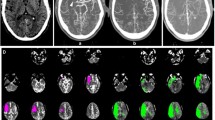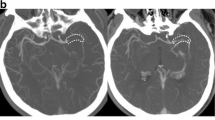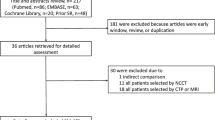Abstract
Objectives
It is unclear which selection strategy, plain CT vs. CT perfusion (CTP), is more powerful in predicting outcome after mechanical thrombectomy (MT). We aimed to compare the effect of plain CT and CTP in predicting outcome after MT within 6 h.
Methods
We conducted a prospective analysis of a retrospective cohort from our single-center study, which had occlusion of the internal carotid artery and middle cerebral artery up to the proximal M2 segment and received MT within 6 h. According to the Alberta Stroke Program Early CT Score (ASPECTS), patients were divided into a high-ASPECTS group (≥ 6) and a low ASPECTS group (< 6). Similarly, patients were divided into mismatch and no-mismatch groups according to the DEFUSE3 criteria for CTP. A good outcome was defined as a 90-day modified Rankin Scale (mRS) score of ≤ 3. Univariate and binary logistic regression analyses were used to investigate the association between different imaging modality and 90-day mRS score, and mortalities, respectively.
Results
The high ASPECTS group included 307 patients (89.2%). The mismatch group included 189 (54.9%) patients meeting the DEFUSE3 criterion. Compared to the low ASPECTS group, the high ASPECTS group had a good outcome (odds ratio (OR), 2.285; [95% confidence interval (CI) (1.106, 4.723)], p = 0.026) and lower mortality (OR, 0.350; [95% CI (0.163, 0.752)], p = 0.007). However, there were no significant differences in good outcomes and mortality between the mismatch and no-mismatch groups.
Conclusions
Compared with plain CT, CTP does not provide additional benefits in the selection of patients suitable for MT within 6 h.
Clinical relevance statement
CT perfusion is not superior to plain CT for the prediction of clinical outcomes when selecting patients for mechanical thrombectomy in the first 6 h. In that clinical setting, plain CT may be safe in the absence of perfusion data.
Key Points
• The advantage of CT perfusion (CTP) over CT in pre-mechanical thrombectomy (MT) screening has not been proven for patients with a large infarct core.
• CTP is not better than plain CT in predicting good outcome following MT within 6 h.
• Plain CT is sufficient for selecting patients suitable for MT within 6 h of large artery occlusion.


Similar content being viewed by others
Abbreviations
- AIS:
-
Acute ischemic stroke
- AOL:
-
Arterial occlusive lesion
- ASPECTS:
-
Alberta Stroke Program Early CT Score
- CI:
-
Confidence interval
- CTP:
-
CT perfusion
- IQR:
-
Interquartile range
- IVT:
-
Intravenous thrombolysis
- LVO:
-
Large vessel occlusion
- mRS:
-
Modified Rankin Scale
- MT:
-
Mechanical thrombectomy
- NIHSS:
-
National Institutes of Health Stroke Scale
- OR:
-
Odds ratio
- PH:
-
Parenchymal hematoma
- RCTs:
-
Randomized controlled trials
- SD:
-
Standard deviation
- sICH:
-
Symptomatic intracerebral hemorrhage
- TIA:
-
Transient ischemic attack
References
Chen Z, Zhang M, Shi F et al (2018) Pseudo-occlusion of the internal carotid artery predicts poor outcome after reperfusion therapy. Stroke 49:1204–1209
Saver JL, Goyal M, Bonafe A et al (2015) Stent-retriever thrombectomy after intravenous t-PA vs. t-PA alone in stroke. N Engl J Med 372:2285–2295
Berkhemer OA, Fransen PS, Beumer D et al (2015) A randomized trial of intraarterial treatment for acute ischemic stroke. N Engl J Med 372:11–20
Goyal M, Demchuk AM, Menon BK et al (2015) Randomized assessment of rapid endovascular treatment of ischemic stroke. N Engl J Med 372:1019–1030
Jovin TG, Chamorro A, Cobo E et al (2015) Thrombectomy within 8 hours after symptom onset in ischemic stroke. N Engl J Med 372:2296–2306
Campbell BC, Mitchell PJ, Kleinig TJ et al (2015) Endovascular therapy for ischemic stroke with perfusion-imaging selection. N Engl J Med 372:1009–1018
Bracard S, Ducrocq X, Mas JL et al (2016) Mechanical thrombectomy after intravenous alteplase versus alteplase alone after stroke (THRACE): a randomised controlled trial. Lancet Neurol 15:1138–1147
Martins SO, Mont’Alverne F, Rebello LC et al (2020) Thrombectomy for stroke in the public health care system of Brazil. N Engl J Med 382:2316–2326
von Kummer R, Broderick JP, Campbell BC et al (2015) The Heidelberg Bleeding Classification: classification of bleeding events after ischemic stroke and reperfusion therapy. Stroke 46:2981–2986
Albers GW, Marks MP, Kemp S et al (2018) Thrombectomy for stroke at 6 to 16 hours with selection by perfusion imaging. N Engl J Med 378:708–718
Nogueira RG, Jadhav AP, Haussen DC et al (2018) Thrombectomy 6 to 24 hours after stroke with a mismatch between deficit and infarct. N Engl J Med 378:11–21
Jovin TG, Li C, Wu L et al (2022) Trial of thrombectomy 6 to 24 hours after stroke due to basilar-artery occlusion. N Engl J Med 387:1373–1384
Nogueira RG, Haussen DC, Liebeskind D et al (2021) Stroke imaging selection modality and endovascular therapy outcomes in the early and extended time windows. Stroke 52:491–497
Jadhav AP, Goyal M, Ospel J et al (2022) Thrombectomy with and without computed tomography perfusion imaging in the early time window: a pooled analysis of patient-level data. Stroke 53:1348–1353
Powers WJ, Rabinstein AA, Ackerson T et al (2019) Guidelines for the early management of patients with acute ischemic stroke: 2019 update to the 2018 Guidelines for the Early Management of Acute Ischemic Stroke: a guideline for healthcare professionals from the American Heart Association/American Stroke Association. Stroke 50:e344–e418
Brott T, Adams HP Jr, Olinger CP et al (1989) Measurements of acute cerebral infarction: a clinical examination scale. Stroke 20:864–870
Pexman JH, Barber PA, Hill MD et al (2001) Use of the Alberta Stroke Program Early CT Score (ASPECTS) for assessing CT scans in patients with acute stroke. AJNR Am J Neuroradiol 22:1534–1542
Bang OY, Saver JL, Kim SJ et al (2011) Collateral flow predicts response to endovascular therapy for acute ischemic stroke. Stroke 42:693–699
Dhillon PS, Butt W, Podlasek A et al (2022) Perfusion imaging for endovascular thrombectomy in acute ischemic stroke is associated with improved functional outcomes in the early and late time windows. Stroke 53:2770–2778
Goyal M, Menon BK, van Zwam WH et al (2016) Endovascular thrombectomy after large-vessel ischaemic stroke: a meta-analysis of individual patient data from five randomised trials. Lancet 387:1723–1731
Mokin M, Pendurthi A, Ljubimov V et al (2018) ASPECTS, large vessel occlusion, and time of symptom onset: estimation of eligibility for endovascular therapy. Neurosurgery 83:122–127
Bhuva P, Yoo AJ, Jadhav AP et al (2019) Noncontrast computed tomography Alberta Stroke Program Early CT Score may modify intra-arterial treatment effect in DAWN. Stroke 50:2404–2412
Nguyen TN, Abdalkader M, Nagel S et al (2022) Noncontrast computed tomography vs computed tomography perfusion or magnetic resonance imaging selection in late presentation of stroke with large-vessel occlusion. JAMA Neurol 79:22–31
Acknowledgements
Z.C. had full access to all the data in the study and take responsibility for the integrity of the data and the accuracy of the data analysis. Z.C. designed the whole study and supervised the whole project, monitored data collection, drafted the manuscript, and approved the final version of the manuscript. Concept and design: Y.P. and Z.C. Acquisition, analysis, or interpretation of data: Y.P., YC. Critical revision of the manuscript for important intellectual content: Y.P., YC, WZ, YH, YZ, ML. Statistical analysis: Y.P., YC. Obtained funding: Z.C., ML. All authors contributed to the development of the manuscript and approved the final draft. The corresponding authors attest that all listed authors meet authorship criteria and that no others meeting the criteria have been omitted.
Funding
This study was supported by the National Natural Science Foundation of China (81971101, 82171276).
Author information
Authors and Affiliations
Corresponding authors
Ethics declarations
Guarantor
The scientific guarantor of this publication is Zhicai Chen.
Conflict of interest
The authors of this manuscript declare no relationships with any companies whose products or services may be related to the subject matter of the article.
Statistics and biometry
No complex statistical methods were necessary for this paper.
Informed consent
Written informed consent for MT was obtained from all patients or their legally authorized representatives. Because patient information was de-identified and anonymized before being released to the researchers, the informed consent requirement for this study was waived by the Institutional Review Board.
Ethical approval
Institutional Review Board approval was obtained. The study protocol was approved by the ethics committee of the Second Affiliated Hospital of Zhejiang University, School of Medicine. The study was conducted according to the principle expressed in the Declaration of Helsinki.
Study subjects or cohorts overlap
None of the study subjects or cohorts has been previously reported.
Methodology
• retrospective
• observational
• performed at one institution
Additional information
Publisher's note
Springer Nature remains neutral with regard to jurisdictional claims in published maps and institutional affiliations.
Rights and permissions
Springer Nature or its licensor (e.g. a society or other partner) holds exclusive rights to this article under a publishing agreement with the author(s) or other rightsholder(s); author self-archiving of the accepted manuscript version of this article is solely governed by the terms of such publishing agreement and applicable law.
About this article
Cite this article
Pei, Y., Chen, Y., Zhong, W. et al. Effect of computed tomography vs. computed tomography perfusion on mechanical thrombectomy outcomes within 6 hours. Eur Radiol (2024). https://doi.org/10.1007/s00330-023-10545-y
Received:
Revised:
Accepted:
Published:
DOI: https://doi.org/10.1007/s00330-023-10545-y




